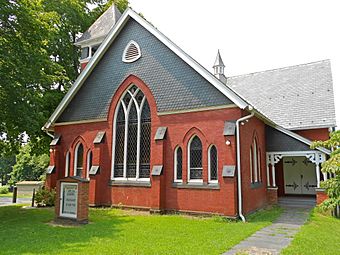Delta Historic District facts for kids
Quick facts for kids |
|
|
Delta Historic District
|
|

Welsh Chapel, the northern end of the district
|
|
| Location | Main St., Delta, Pennsylvania |
|---|---|
| Area | 71.3 acres (28.9 ha) |
| Architectural style | Greek Revival, Late Victorian |
| NRHP reference No. | 83002288 |
| Added to NRHP | September 15, 1983 |
The Delta Historic District is a special area in Delta, Pennsylvania, located in York County, Pennsylvania. It's called a "historic district" because it has many old buildings that are important to the area's history. This district is officially recognized as a national historic place in the United States.
Most of the buildings in the Delta Historic District were built a long time ago, between 1875 and 1895. There are 137 buildings in total! These buildings often have wooden frames and are covered with "clapboard," which are long, thin wooden boards. They usually sit on foundations made of slate rock and have roofs covered with slate shingles.
The buildings show off different old building styles, like the Greek Revival and Late Victorian styles. The fact that so many buildings use slate shows how important the slate mining industry was to the town of Delta back then. It was a big part of their economy and provided many jobs.
What Makes Delta Historic?
The Delta Historic District was added to the National Register of Historic Places in 1983. This is a list kept by the U.S. government that includes places important to American history. Being on this list helps protect these special places for future generations to enjoy and learn from.
Buildings and Their Styles
The buildings in the district tell a story about how people lived and built homes over a hundred years ago. They are mostly made of wood, a common building material at the time.
- Clapboard: This is a type of wooden siding used on the outside of many houses. It helps protect the house from weather.
- Slate: This is a type of rock that can be split into thin, flat pieces. It was used for foundations because it's strong, and for roofs because it's durable and waterproof.
The architectural styles you can see, like Greek Revival and Late Victorian, were very popular during the late 1800s. Greek Revival buildings often look like ancient Greek temples, with columns and simple, grand designs. Late Victorian buildings are usually more decorative, with fancy details, towers, and different textures.
The Importance of Slate
Delta, Pennsylvania, was well-known for its slate quarries. A quarry is a place where stone is dug out of the ground. The slate industry was a huge part of Delta's economy. Many people worked in the quarries, and the slate was used for roofs, blackboards, and even sidewalks all over the country. The buildings in the historic district show how much slate was used locally, reflecting its importance to the town's growth and prosperity.



